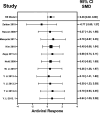The potential of IFN-λ, IL-32γ, IL-6, and IL-22 as safeguards against human viruses: a systematic review and a meta-analysis
- PMID: 38420119
- PMCID: PMC10899505
- DOI: 10.3389/fimmu.2024.1303115
The potential of IFN-λ, IL-32γ, IL-6, and IL-22 as safeguards against human viruses: a systematic review and a meta-analysis
Abstract
Many studies have investigated the antiviral activity of cytokines, including interleukin-6 (IL-6), interleukin-22 (IL-22), interleukin-32 gamma (IL-32γ), and interferon-lambda (IFN-λ) in diverse populations. This study aims to evaluate the role of these cytokines in inhibition of various human and animal viruses when administered exogenously. A comprehensive meta-analysis and systematic review were conducted on all the relevant studies from three databases. Standard mean differences (SMDs) of overall viral inhibition were used to generate the difference in the antiviral efficacy of these cytokines between control and experimental groups. A total of 4,618 abstracts for IL-6, 3,517 abstracts for IL-22, 2,160 abstracts for IL-32γ, and 1,026 abstracts for IFN-λ were identified, and 7, 4, 8, and 35 studies were included, respectively, for each cytokine. IFN-λ (SMD = 0.9540; 95% CI: 0.69-0.22) and IL-32γ (SMD = 0.459; 95% CI: 0.02-0.90) showed the highest influence followed by IL-6 (SMD = 0.456; CI: -0.04-0.95) and IL-22 (SMD = 0.244; 95% CI: -0.33-0.81). None of the cytokines represented heterogeneity (tau² > 0), but only IFN-λ indicated the funnel plot asymmetry (p = 0.0097). Results also indicated that IFN-λ and IL-32γ are more potent antivirals than IL-6 and IL-22. The collective findings of this study emphasize that exogenously administered pro-inflammatory cytokines, specifically IFN-λ and IL-32, exhibit a significant antiviral activity, thereby underscoring them as potent antiviral agents. Nonetheless, additional research is required to ascertain their clinical utility and potential for integration into combinatorial therapeutic regimens against viral infections.
Keywords: antiviral; interferon-lambda; interleukin-22; interleukin-32 gamma; interleukin-6.
Copyright © 2024 Sattar, Qaiser, Kausar, Aqil, Mudassar, Manzoor and Ashraf.
Conflict of interest statement
The authors declare that the research was conducted in the absence of any commercial or financial relationships that could be construed as a potential conflict of interest.
Figures





Similar articles
-
Effects of Traditional Chinese Medicine on Serum Cytokines for the Dampness-heat Syndrome of Ulcerative Colitis: A Systematic Review and Meta-analysis.Altern Ther Health Med. 2023 Jul;29(5):386-395. Altern Ther Health Med. 2023. PMID: 37171947
-
Current Landscape of IFN-λ: Induction, Inhibition, and Potential Clinical Applications to Treat Respiratory Viral Infections.Immunohorizons. 2023 Apr 1;7(4):265-272. doi: 10.4049/immunohorizons.2200010. Immunohorizons. 2023. PMID: 37071039 Free PMC article.
-
Lambda interferon (IFN-lambda), a type III IFN, is induced by viruses and IFNs and displays potent antiviral activity against select virus infections in vivo.J Virol. 2006 May;80(9):4501-9. doi: 10.1128/JVI.80.9.4501-4509.2006. J Virol. 2006. PMID: 16611910 Free PMC article.
-
Inducible interleukin 32 (IL-32) exerts extensive antiviral function via selective stimulation of interferon λ1 (IFN-λ1).J Biol Chem. 2013 Jul 19;288(29):20927-20941. doi: 10.1074/jbc.M112.440115. Epub 2013 May 31. J Biol Chem. 2013. PMID: 23729669 Free PMC article.
-
Interferons lambda, new cytokines with antiviral activity.Acta Virol. 2013;57(2):171-9. doi: 10.4149/av_2013_02_171. Acta Virol. 2013. PMID: 23600875 Review.
Cited by
-
Intersecting transcriptomic landscapes of hypertension and kidney function in African American women.Am J Physiol Renal Physiol. 2025 Jul 1;329(1):F59-F70. doi: 10.1152/ajprenal.00067.2025. Epub 2025 May 30. Am J Physiol Renal Physiol. 2025. PMID: 40445960 Free PMC article.
References
-
- Verhoef J, van Kessel K, Snippe H. Immune response in human pathology: infections caused by bacteria, viruses, fungi, and parasites. Nijkamp Parnhams Princ Immunopharmacol (2019), 165–78. doi: 10.1007/978-3-030-10811-3_10 - DOI
-
- Pappas DE. The common cold. Princ Pract Pediatr Infect Dis (2018), 199–202.e1. doi: 10.1016/B978-0-323-40181-4.00026-8 - DOI
Publication types
MeSH terms
Substances
LinkOut - more resources
Full Text Sources

